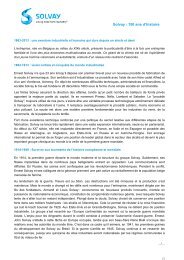solvay_live243_p02a04 somEdito
solvay_live243_p02a04 somEdito
solvay_live243_p02a04 somEdito
You also want an ePaper? Increase the reach of your titles
YUMPU automatically turns print PDFs into web optimized ePapers that Google loves.
Dossier<br />
105021<br />
64<br />
SOLVAY IS OPENING THE GROUP’S<br />
LARGEST R&T CENTER TO START-UPS<br />
GIVING START-UPS<br />
A KICK START ON THE<br />
BELGIUM-NOH R&T SITE<br />
SolvayInnovationTrophy2006<br />
Start-ups have to find their way in a very<br />
competitive world that is calling out both<br />
for the rapid emergence of new and high<br />
performance technologies and for drastic cuts<br />
in research costs. These start-ups, which grow<br />
around an initial idea, often find it difficult<br />
to cope with the scientific, technical, legal and<br />
administrative demands placed upon them.<br />
In line with its tradition of offering support<br />
to science, Solvay Research & Technology wants<br />
to encourage the spirit of innovation of the<br />
start-ups and welcomes them into its rich universe<br />
of research laboratories, resources and skills<br />
without it costing the earth for them. The young<br />
companies can thus focus their efforts on their<br />
core business in a stimulating environment that<br />
encourages the cross fertilisation of several<br />
disciplines, such as chemicals, engineering,<br />
materials research, etc. With this initiative, Solvay<br />
R&T is becoming an incubator for start-ups<br />
whose fields of activity are close or<br />
complementary to those of the Group.<br />
It is also for Solvay a means of making<br />
its contribution to the construction<br />
of the knowledge society. A first company,<br />
Artelis, active in the field of biotechnology, set up<br />
on the site in December 2005 and has decided<br />
to continue to grow under the protective wing<br />
of Solvay R&T (20 persons are set to be taken<br />
on in 2007). Applications from other start-ups are<br />
currently being examined.<br />
> Carine Demeyer; Paul Baekelmans; Michel Driesen;<br />
Geneviève Fauville; Alfred Hoffait; Bernard Poulin.<br />
> BSC BELGIUM<br />
105191<br />
LUVOX ® /FLUVOXAMINE IN JAPAN<br />
ONE FIRST AFTER ANOTHER<br />
Before the launch of the LUVOX<br />
(fluvoxamine) in 1999, only traditional antidepressants<br />
were commonly used<br />
in Japan, leading to the following situation:<br />
• too many adverse side effects;<br />
• uncertainty as to the possibilities<br />
of developing and finding a potential market<br />
for the SSRI (“Selective Serotonin Reuptake<br />
Inhibitors“);<br />
• a shortage of drugs to treat Obsessive<br />
Compulsive Disorders and SAD (Social<br />
Anxiety Disorders);<br />
• difficulty in finding the appropriate treatment<br />
for children.<br />
Solvay Seiyaku (Japan) therefore came up with<br />
innovative solutions to all of these issues,<br />
by being the first in Japan:<br />
• to successfully launch fluvoxamine in 1999 to<br />
treat depression and obsessive compulsive<br />
disorders, quadrupling this market between<br />
1999 and 2005 warding off reputed<br />
competitors;<br />
• to obtain approval for this drug to treat SAD<br />
and to successfully launch the drug in 2005;<br />
• to launch the paediatric clinical study at the<br />
beginning of 2006.<br />
The sheer quality of the approach, from the<br />
clinical studies to the market entry, including<br />
the risk taking, the rapid decision-making, the<br />
creation of a standardised diagnosis scale,<br />
recognised and used by the entire profession,<br />
attracted partners to these projects (Meiji<br />
Seika) and was applauded by the authorities.<br />
The result, yet again a first in Japan<br />
in the pharmaceutical industry, was the<br />
awarding of a maximum extension<br />
of marketing exclusivity for these drugs.<br />
This, of course, to the benefit of the patients<br />
who, thanks to fluvoxamine, can look forward<br />
to an improvement in their quality of life.<br />
> Toshiki Tsuji; Guenter Krause; Koji Ohiwa.<br />
> PHARMACEUTICALS SECTOR<br />
101500<br />
USE OF PURIFIED BRINE INSTEAD OF SOLID<br />
SALT TO FEED ELECTROLYSIS PLANT WITH NaCI<br />
A DOUBLE ECONOMY<br />
The salt used to feed the membranes of the<br />
electrolysis plant needs to be purified. This<br />
is traditionally carried out via drying<br />
operations through the evaporation of the<br />
brine transported by pipe in its liquid form.<br />
However, the evaporation operations are high<br />
consumers of energy.<br />
The aim of this project is twofold:<br />
• to reduce the total quantity of salt purified<br />
by evaporation, leading to energy savings;<br />
• to feed the Antwerp (Belgium) electrolysis<br />
plant with our salt instead of buying it from<br />
external suppliers, at times of strong demand,<br />
leading to purchasing savings.<br />
To do so, in Jemeppe (Belgium)) we directly<br />
feed the electrolysis plant with saturated<br />
brine without going through the<br />
crystallisation stage. However, it is still<br />
necessary to purify this brine via a new<br />
nanofiltration technology.<br />
The capacity of purification by crystallisation<br />
that is thus freed up in Jemeppe, allows us to<br />
purify the salt for the Antwerp electrolysis.<br />
The budgetary impact can be directly felt,<br />
both in Jemeppe and Antwerp.<br />
> Pol Henry; Fabrizio Aversa; Vittorio Benso;<br />
Alain Hanneuse; Pierre Mauroy; Stéphane Pestiaux.<br />
> SBU VINYLS


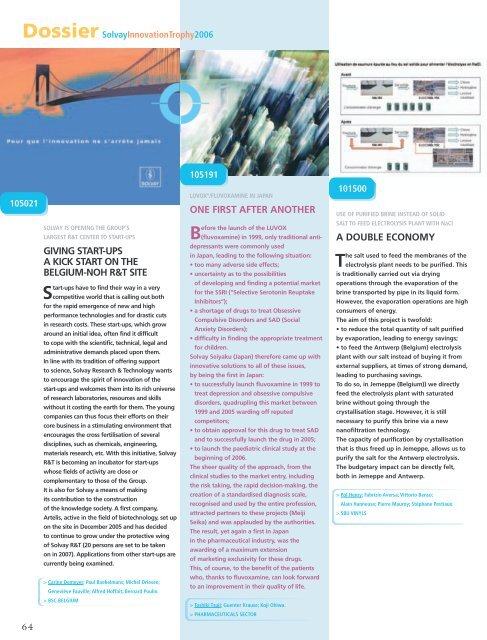

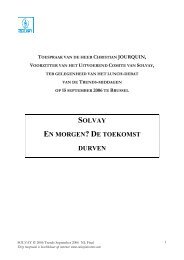
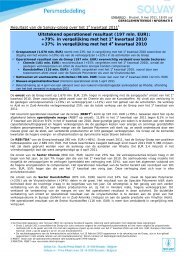

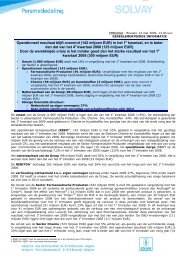



![PROC.1 [LETTRE] - Solvay](https://img.yumpu.com/16585746/1/184x260/proc1-lettre-solvay.jpg?quality=85)
